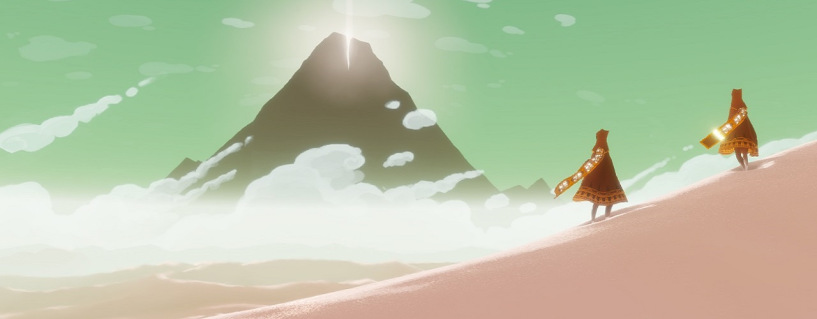[Well, That Was Interesting is our weekly look back at a few interesting and notable items from around the internet. Full credit is paid to authors with links to their full articles provided in an effort to highlight important ideas that don't always have to relate to the world of videogames. We provide our opinion on selected pieces and why we think they are worth your time, and you can follow the links to read the full articles.]
The individual articles chosen for this week’s Big Four all build into a larger narrative of change that is taking place within different segments of the industry as a whole, and how they relate to other media industries. Because, let’s face it, the times they are a-changing - and not many are willing to acknowledge these changes.
 Last week we discussed the rise of YouTube as a media platform and its impact on larger telecommunication companies, and how even those of you who don’t ever use the site are having your wallets affected by it. The rise of YouTube and Twitch has given rise to a new way to experience games with Let’s Plays and video reviews. Mike Rose has a great piece on the impact that YouTube has had on indie videogame development and how little of an impact more traditional written journalism outlets have had on those same games. Ironically enough we’ll tell you it’s a great read, as there is no video for it yet.
Last week we discussed the rise of YouTube as a media platform and its impact on larger telecommunication companies, and how even those of you who don’t ever use the site are having your wallets affected by it. The rise of YouTube and Twitch has given rise to a new way to experience games with Let’s Plays and video reviews. Mike Rose has a great piece on the impact that YouTube has had on indie videogame development and how little of an impact more traditional written journalism outlets have had on those same games. Ironically enough we’ll tell you it’s a great read, as there is no video for it yet.
Our second piece is a 14-year look back of the evolving videogame industry through the eyes of the writers at develop magazine, who have just published their 150th issue of their magazine. James Batcher discusses how much has changed for developers and publishers in such a short time span, and credits the rise of social media and crowdsourcing. These new online outlets build a greater inclusion in the community and have given rise to smaller studios making smaller games at a fraction of the cost of larger studios, and all the while they’re hugely financially successes.
But crowd sourcing and funding games comes with its own set of inherent problems and risks, and even though the process has been around for a few years now there are still a lot people who don’t know about it. We’ve covered Kickstarter projects in the past and take an interest in this new method of game creation, and the role the community at large plays in it. Stephanie Carmichael has a great interview with Jean-Francois Major of Tribute Games on their recently launched Mercenary Kings, and what it was like going through both Steam Early Access and Kickstarter.
Speaking of the community as a whole, what happens when you release your vision to the public and the public takes your game and runs with it in ways you never expected? We mentioned the rising controversy over the changes Notch has made in regards to third-party servers and their monetization of Minecraft, which Notch is directly opposed to. Fans have spoken out in outrage over these upcoming changes and many have enjoyed the services offered by third-party servers, and the changes will end these services. Adam Smith of Rock, Paper, Shotgun has a great interview with Notch himself, who explains the reasons behind these changes and the role of free-to-play.
Well, Where is this all going?
These four articles only touch on a fraction of the changes taking place to industries in the new digital economy, and the videogame industry has undergoing radical changes in recent times. These changes have happened at such a rapid rate that one time industry giants are finding themselves in weaker positions as they try to cling onto old models of business.
Twitter has exploded over the last few weeks at the news of layoffs and departures of journalist from many big name gaming outlets, but this is not isolated to only the gaming industry. Traditional new print media has been undergoing radical changes with the rise of the internet and the citizen journalist, bloggers, and television. Many would argue that these changes have been ongoing since the first time television broadcasted the nightly news. The reading of books has been on a noticeable decline for years, and again it could be argued that videogames have had a lasting impact on reading.
 Videogames already cater to an audience that is enthralled with visual media and less with reading and books. Gaming journalism caters to an audience that is already more tech-savvy than the average person, and this is an audience that is already has a higher predisposition to watching media than reading. Watching a YouTube video is not only easier but arguably worth more as pictures are worth a thousand words. Viewers are able to see for themselves the features of their potential purchases, and could then make a more informed purchasing decision.
Videogames already cater to an audience that is enthralled with visual media and less with reading and books. Gaming journalism caters to an audience that is already more tech-savvy than the average person, and this is an audience that is already has a higher predisposition to watching media than reading. Watching a YouTube video is not only easier but arguably worth more as pictures are worth a thousand words. Viewers are able to see for themselves the features of their potential purchases, and could then make a more informed purchasing decision.
Not only that, but there are a lot of things competing for the attention of people, and many choose to engage in more than once source at a time. How often have you watched a movie streaming from Netflix or Hulu while surfing on your laptop and checking your phone for tweets? I would imagine quite a few of you would say you’ve had this experience at least once, and many might have this experience on a daily basis. This is partially why there has been a decline in movie theater attendance as it is a lot to ask of connected people to put down their phones for two hours.
These changes have impacted the way games are being made with smaller teams able to cater to a specific audience that they can reach through social media. This allows for a more specialized gaming experience and has seen a resurgence of retro games on Kickstarter, Early Access, and Green Light. With social media having such an influence on the development side it is no surprise that games are trying to incorporate these tools into their games, leading to the development of games that are intended to be played on Twitch with an audience watching.
Free-to-play games are only making the industry more uneasy as the quality of those games rises and the scamming decreases. MMO’s have been devastated by the free-to-play model and really only Eve and World of Warcraft have been able to stand up to these changes, but they’ve had a long existing player base that existed before these changes. What will be next?
Now we’re not saying that nobody reads books or articles anymore – as hopefully you are reading this right now – but these changes are coming, and maybe not tomorrow but soon the changes will kick into high gear. And we’re not trying to be alarmist about this either as many of these changes are awesome and empower more and more people every day to take part in an industry that they love.
On the subject of reading, it is entirely plausible that there will one day be a computer powerful enough to read a book and translate the text into a visual experience. This will be something more than television and more than videogames, and damn will that be interesting.
As always, here’s to another good week. Cheers.
The Big Four
Is YouTube killing the traditional games press?
 There’s been a notable shift in the video game industry that many traditional game critics would rather turn a blind eye to than investigate.
There’s been a notable shift in the video game industry that many traditional game critics would rather turn a blind eye to than investigate.
It’s the rise of the “YouTuber,” pulling in hundreds and thousands of rabid fans and causing incredible traffic and sales spikes for game developers, while the written word continues to trundle along, looking more and more quaint with each passing day.
Getting covered by a big-name YouTuber is now essentially the dream of many game developers. The publicity someone like TotalBiscuit, NerdCubed or Northernlion can bring you compared to mainstay consumer websites like IGN, GameSpot and Game Informer is becoming increasingly significant.
A year ago, I would have advised any developer to get in touch with as many press outlets as possible, as soon as possible. I still advise this now, but with the following caveat: You’re doing so to get the attention of YouTubers.
But view stats and subscribers numbers mean nothing without evidence that these videos are actually making a difference to the featured developers. Gamasutra got in contact with numerous devs to find out just how much of an impact YouTuber coverage had for them.
There’s been a notable shift in the video game industry that many traditional game critics would rather turn a blind eye to than investigate.
It’s the rise of the “YouTuber,” pulling in hundreds and thousands of rabid fans and causing incredible traffic and sales spikes for game developers, while the written word continues to trundle along, looking more and more quaint with each passing day.
Getting covered by a big-name YouTuber is now essentially the dream of many game developers. The publicity someone like TotalBiscuit, NerdCubed or Northernlion can bring you compared to mainstay consumer websites like IGN, GameSpot and Game Informer is becoming increasingly significant.
How times have changed: Develop legends discuss an evolving industry
 To celebrate our 150th issue, we gathered some of our most notable cover stars to mull over how development has changed in the last decade and a half. James Batchelor caught up with the faces of Develop magazine’s past
To celebrate our 150th issue, we gathered some of our most notable cover stars to mull over how development has changed in the last decade and a half. James Batchelor caught up with the faces of Develop magazine’s past
December 2000 saw the arrival of a brand new monthly bible for games developers. Staring from the front page, arms folded to emphasise the severity of his message, was Kuju Entertainment’s Ian Baverstock with
a striking claim about the future of games development. His was the first of many faces to grace the cover of Develop.
Last month, Baverstock – now at Tenshi Partners, a firm he founded in 2010 – and five of his fellow cover stars came to London to reflect on what has transpired since that first interview. Nearly 14 years on, the industry is a different place for developers – and certainly very different to the one Baverstock predicted in our inaugural issue.
“In 2000, I said everyone should grow up, get to be bigger and small studios are going to die,” he says. “Now, I think it’s pretty much the opposite – they’re having a great time. They have a wonderful environment to be in, lots of innovation, they can make games for not a lot. We’ve got a proper indie scene.”
David Braben, founder of Frontier Developments, adds: “That comes from the fact that the balance of power has changed. The power has moved from publishing to content creation. We’ve got a lot of services that have democratised the discovery of games, where indies can sit alongside EA.
“The problem is a lot of previous developers haven’t necessarily adapted to it well. And I think that’s part of why we’ve seen the rise of the indies, although most of them are not doing very well financially.”
What one studio says the media, gamers, and developers get wrong about Steam’s Early Access
 Steam’s Early Access is a bit of a mystery. Players know it enables them to try out upcoming PC and Mac games before they launch, but it’s easy to chalk the program up as any other beta or alpha release.
Steam’s Early Access is a bit of a mystery. Players know it enables them to try out upcoming PC and Mac games before they launch, but it’s easy to chalk the program up as any other beta or alpha release.
To Jean-Francois Major, the cofounder of Mercenary Kings developer Tribute Games, both assessments aren’t wrong as much as they’re inadequate. The program — part of Valve’s digital-games distribution service, Steam — was the next step in the 2D action-platformer’s public development after it exceeded its crowdfunding goal of $75,000 (it raised $116,064 total) on Kickstarter in September 2012. We followed the indie studio’s progress with Early Access from when it began last year in August through the seven months leading up to Mercenary King’s launch today, March 25, for PC and April 1 for PlayStation 4.
What the media doesn’t understand
If you’re a member of the press, you’re probably dealing with Early Access all wrong — or at least, not in the way developers want you to.
“I think my main concern is with media,” Major told GamesBeat. “Not all of them seem to really grasp what Early Access is. Or they don’t quite know how to handle Early Access games. We’ve had countless reviews when they should be treated as preview, some of them pointing out issues we resolved a week later. I’d say most reviews will require to be rewritten — very unlikely — by the time the game launches as it won’t represent the final product.”
Not all early coverage is detrimental. For one, it gives prospective paying customers an idea of what they’re getting into upfront, and it can help dispel misconceptions.
“One thing that we’ve been struggling with is distancing ourselves from being considered ‘just another Metal Slug clone’ when we feel the game is much more than that,” he said. “Pretty much all articles we get are quick to mention that this is not the case. So I feel it has helped thus far.”
Pay To Play: Notch On Minecraft And Monetisation
 You may have heard that changes are afoot in the world of Minecraft. You may also have heard that nothing much is changing at all. The story of monetisation, community and servers has led to plenty of discussion and rhetoric from various sides, and the issues at the heart of the situation haven’t always been clear. I spent some time last week looking into the rise of for-profit Minecraft servers, a development I hadn’t followed over the months. Armed with fresh knowledge and thoughts, I spoke to Markus “Notch” Persson, the game’s creator and Mojang’s majority owner.
You may have heard that changes are afoot in the world of Minecraft. You may also have heard that nothing much is changing at all. The story of monetisation, community and servers has led to plenty of discussion and rhetoric from various sides, and the issues at the heart of the situation haven’t always been clear. I spent some time last week looking into the rise of for-profit Minecraft servers, a development I hadn’t followed over the months. Armed with fresh knowledge and thoughts, I spoke to Markus “Notch” Persson, the game’s creator and Mojang’s majority owner.
Before reading on, please note that Notch answered these questions to give his personal view and is not speaking from a legal perspective. He is not driving these decisions, having moved ‘into a cozy corner…to work on new smaller games in relative secrecy’, but I hoped that speaking with him would shed some light on the company’s stance toward creators, community and cashing-in.
RPS: The terms around server access and subscriptions have caused a lot of confusion and noise in the last couple of weeks. Is there a simple message in your mind as to the business or ethical policy behind the rules that will be enforced from August 1st?
Notch: The first thing I want people to understand is that the rules haven’t changed for the worse. Before you couldn’t charge for anything in the game (you could charge for access), but we’ve changed that to allow for charging for things purely cosmetic things. What constitutes cosmetic is difficult to nail down as it depends on what kind of server you’re running. In a creative server with no combat or mobs, swords are cosmetic, but in a server with pvp or enemies, they are not.
Visual Stimulation
Vsauce - PORTALS
Are Steam Sales as Good as They Used to Be?
Did you know gaming? Doom
In keeping with the theme of change in the industry this look back at the classic game Doom provides some interesting context on narrative and game development.
Extra Study Material
One of the better parts of Assassin’s Creed IV is the games “real world” outside of the Animus and the meta-commentary it provides on the franchise. Sam Barsanti gives his opinions on the franchise and the lightning in a bottle story of ACIV in, “Assassin’s Creed IV turns a dull framing device into a deep meta-joke”
The Dota 2 International Tournament is soon upon us, and there has been a bit of a controversy brewing between Valve and team Fnatic over the mental health of one of their members. Alexa Ray Corriea chronicles the ongoing pressure from Valve to send one of Fnatic’s members to the tournament despite health concerns. “Why Valve wants a Dota 2 pro to compete at The International, despite his team’s concerns”








